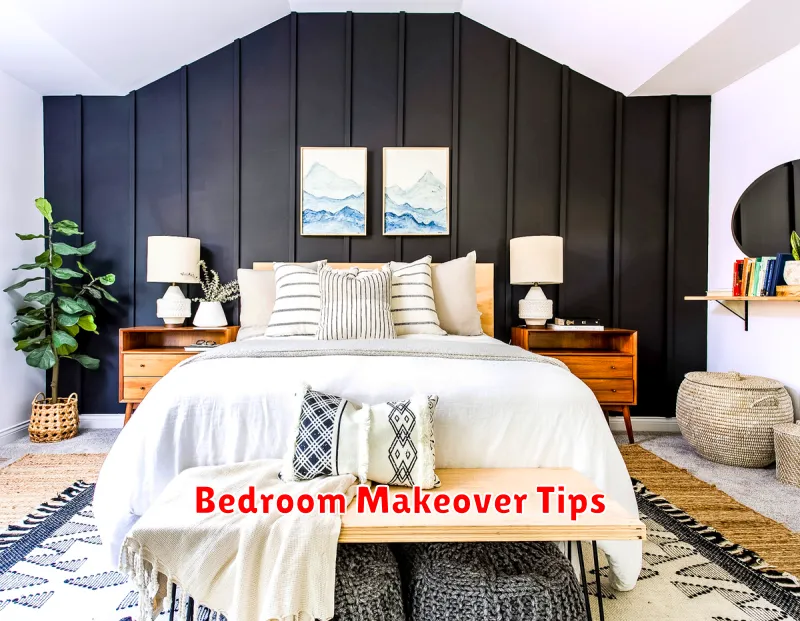Transform your bedroom into a tranquil retreat with these 10 simple bedroom makeover ideas. Whether you’re looking for a quick and easy refresh or a complete bedroom transformation, this guide offers affordable and stylish solutions to revitalize your personal sanctuary. Discover easy DIY projects, clever decorating tips, and budget-friendly ways to achieve a stunning bedroom makeover that reflects your unique style and enhances your sleep quality. Get inspired and start creating your dream bedroom today!
Add a Headboard Accent
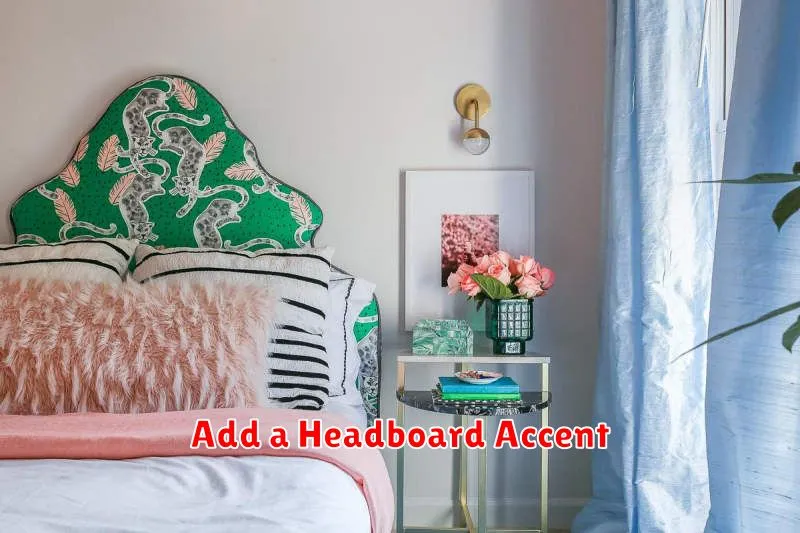
A headboard is a crucial element in bedroom design, offering both aesthetic appeal and functionality. Adding a headboard can instantly transform the look of your bedroom, creating a more cohesive and stylish space. A well-chosen headboard serves as a focal point, drawing the eye and adding a touch of personality to the room.
Consider the style of your bedroom when selecting a headboard. A minimalist bedroom might benefit from a sleek, modern headboard, while a more traditional room might be enhanced by an ornate, upholstered piece. Size and scale are also important factors; a headboard that’s too large or too small can disrupt the overall balance of the room. Think about the proportion of the headboard in relation to the bed and the rest of the furniture.
The material of your headboard is another key consideration. Upholstered headboards offer comfort and a luxurious feel, while wooden headboards provide a more rustic or contemporary aesthetic, depending on the style. Metal headboards can bring an industrial or vintage touch. The color and texture of the headboard should complement the existing color palette and overall design scheme of the bedroom.
Beyond the aesthetic aspects, a headboard can offer practical benefits. It can provide additional support for pillows, creating a more comfortable sleeping experience. It can also help to define the sleeping area, making the bedroom feel more organized and well-defined. In short, selecting and adding a headboard can be a relatively simple yet impactful way to enhance the overall look and feel of your bedroom.
Rearrange Furniture for a New Look
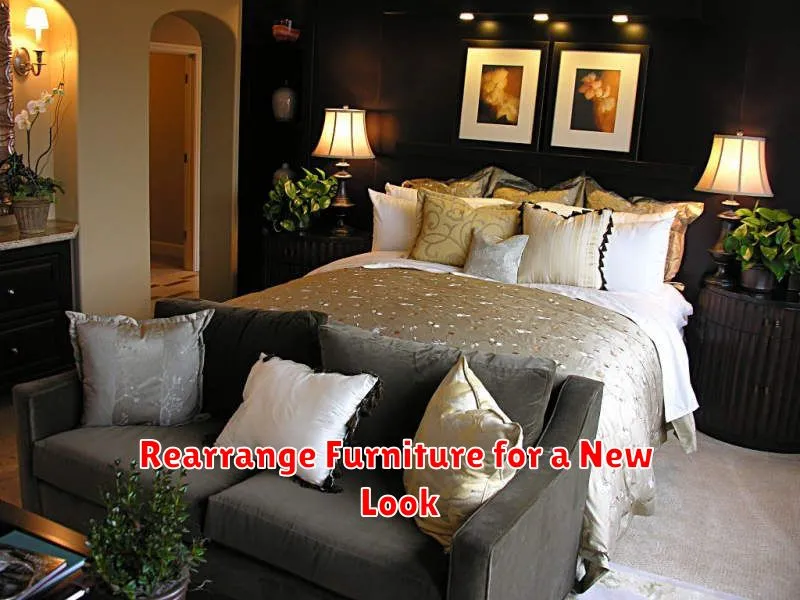
Transforming the look of your living space doesn’t necessitate a complete overhaul or significant financial investment. A simple and effective method involves rearranging your existing furniture. This surprisingly impactful technique can dramatically alter the feel and flow of a room, creating a fresh and exciting environment.
Before embarking on the rearrangement, planning is crucial. Consider the focal point of the room. This could be a fireplace, a large window with a scenic view, or a particularly striking piece of artwork. Arrange your seating to face this focal point, encouraging natural conversation flow and creating a sense of visual harmony. Measure your furniture beforehand to ensure pieces fit comfortably in their new locations and allow for adequate walkway space.
Experiment with different arrangements. Don’t be afraid to try unconventional layouts. For instance, consider positioning a sofa diagonally across the room or placing a chair in an unexpected corner. Try shifting larger pieces first, and then work your way down to smaller items like side tables and accent chairs. This iterative approach allows for flexibility and experimentation. Consider also the traffic flow within the room. Ensure pathways remain unobstructed and easily navigable.
Lighting plays a pivotal role in enhancing your new arrangement. Adjust lighting fixtures to complement the redesigned layout. Perhaps a floor lamp will highlight a new seating area, while strategically placed table lamps can create cozy conversational nooks. Consider introducing new accessories, such as throw pillows, blankets, or rugs to further enhance the refreshed aesthetic. These additions can tie the new arrangement together and inject personality into the space.
Finally, take a step back and evaluate your handiwork. Does the arrangement feel balanced and inviting? Does the traffic flow feel natural? Don’t hesitate to make further adjustments until you achieve the desired outcome. The beauty of rearranging furniture is the ability to experiment freely, and the relatively low cost and effort involved in creating a completely new ambiance for your living space.
Layered Bedding Styles
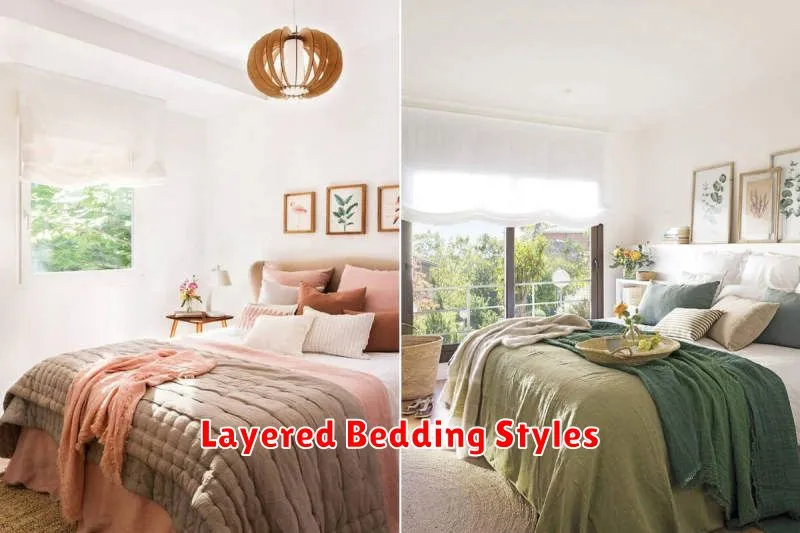
Creating a visually appealing and comfortable bed involves mastering the art of layered bedding. Layering adds texture, depth, and a sense of luxury to your bedroom’s aesthetic. Different layers serve various purposes, from insulation to decoration, contributing to a well-designed and inviting sleep environment.
A basic layered bedding setup typically begins with a fitted sheet, providing the foundational layer that secures the bedding to the mattress. Next, a flat sheet is added, offering a smooth and comfortable surface for sleeping. This is followed by a blanket or comforter, providing warmth and insulation. The comforter is often chosen based on the season and personal preference, ranging from lightweight cotton to heavier down alternatives.
Beyond the essentials, additional layers elevate the look and feel of the bed. A bedspread or quilt can be layered on top of the comforter, adding an extra layer of warmth and visual interest. These often feature intricate designs and textures, enhancing the overall aesthetic appeal. A throw blanket is a versatile addition, offering extra warmth or a pop of color, and can easily be draped over the end of the bed or folded at the foot.
Pillows are crucial for comfort and support, and contribute significantly to the layered look. A variety of pillow sizes and shapes can be incorporated, including standard pillows, Euro pillows for added height and visual impact, and decorative throw pillows to add personality and color. The number and placement of pillows influence the visual layering, creating a sense of fullness and style.
Consider the color palette and texture of each layer when designing your layered bedding. Harmonious color schemes and varied textures create visual interest and depth. For example, pairing a crisp white flat sheet with a textured throw blanket and patterned comforter can achieve a balanced yet striking layered bed. Ultimately, successful layering is about achieving a comfortable and visually satisfying arrangement that reflects personal style and preferences.
Accent Rugs for Comfort

Accent rugs offer a multifaceted approach to enhancing both the aesthetic appeal and comfort levels of a room. They serve as functional floor coverings while simultaneously acting as vibrant design elements, capable of transforming the overall atmosphere.
The primary benefit of an accent rug lies in its ability to add a layer of warmth and softness underfoot. Hardwood floors, while visually appealing, can often feel cold and uninviting. A strategically placed rug provides a welcoming tactile experience, particularly in high-traffic areas such as living rooms and bedrooms.
Beyond the comfort aspect, accent rugs offer significant design advantages. They can be used to define separate zones within an open-plan space, such as delineating a dining area from a living room. The color, pattern, and texture of the rug provide opportunities to introduce visual interest and complement existing décor. A bold rug can serve as a focal point, while a more subtle rug can unify disparate elements.
The material of the rug significantly impacts both its aesthetic and functional qualities. Natural fibers like wool and cotton offer exceptional softness and durability, while synthetic materials like polyester provide greater affordability and ease of maintenance. The choice depends largely on individual preferences, budget constraints, and the specific needs of the room.
In conclusion, the strategic placement of accent rugs offers a practical and aesthetically pleasing method for enhancing the comfort and style of any living space. By carefully considering factors like size, material, color, and pattern, one can seamlessly integrate these versatile floor coverings into their home décor, creating a more inviting and personalized atmosphere.
Floating Nightstands
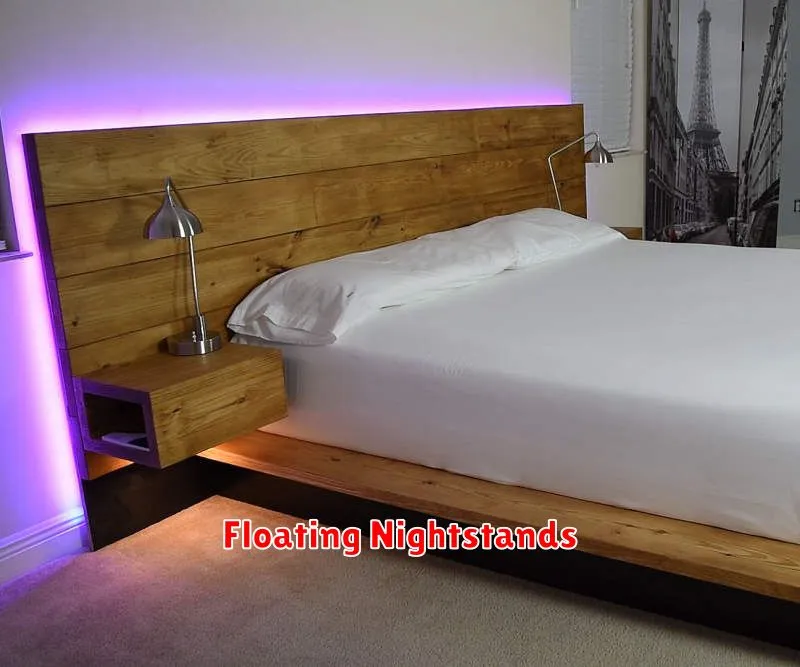
Floating nightstands are a stylish and space-saving solution for bedrooms of all sizes. They offer a sleek, modern aesthetic while maximizing floor space, making them ideal for smaller rooms or those with limited storage.
One of the biggest advantages of a floating nightstand is its ability to create a sense of openness and airiness. By removing the bulk of a traditional nightstand, the room feels less cluttered and more spacious. This is especially beneficial in smaller bedrooms where furniture can easily overwhelm the space.
Design versatility is another key feature. Floating nightstands come in a variety of materials, colors, and styles to suit any bedroom décor. Whether you prefer a minimalist look or something more ornate, there’s a floating nightstand to match your taste. They can easily complement different bed frames and overall room aesthetics.
However, it’s important to consider the practical aspects. Storage space is often limited compared to traditional nightstands. You’ll need to carefully consider what items you need within easy reach before purchasing. Also, the installation process requires some level of DIY skills or professional help, as they need to be securely attached to the wall.
Despite these considerations, the benefits of a floating nightstand often outweigh the drawbacks, especially for those prioritizing a modern, clean look and maximizing space. They’re a great way to add both style and functionality to a bedroom without sacrificing valuable floor area.
Ultimately, the decision of whether or not to choose a floating nightstand depends on individual needs and preferences. Weighing the pros and cons carefully will help you determine if this stylish and space-saving option is the right choice for your bedroom.
Wall Mirrors for Spaciousness

Wall mirrors are a fantastic way to enhance the perceived size and brightness of any room. Their reflective surfaces bounce light around the space, creating an illusion of greater depth and openness. This is particularly beneficial in smaller rooms or areas with limited natural light.
Strategically placing a large mirror on a wall opposite a window can dramatically increase the amount of natural light entering the room. The mirror reflects the sunlight, effectively doubling its impact and brightening even dark corners. This technique is especially effective in hallways or rooms without many windows.
Beyond simply increasing light, mirrors can also create a sense of spaciousness by visually extending the room’s boundaries. A strategically placed mirror can make a small living room feel significantly larger or a cramped bedroom appear more airy. The effect is subtle yet powerful, transforming the overall ambiance of the space.
The size and shape of the mirror play a crucial role in achieving this effect. Larger mirrors generally offer a more pronounced impact on spaciousness. However, a collection of smaller mirrors can also be effective, particularly when arranged creatively to create a unique focal point. The frame also matters; a simple, unobtrusive frame will help the mirror blend seamlessly into the existing décor, whereas an ornate frame might draw too much attention away from the desired effect.
Consider the placement of the mirror carefully. Placing a mirror directly opposite a cluttered area might highlight the mess, so ensure the area reflected is visually appealing. A well-placed mirror can become a stunning design element, enhancing both the functionality and aesthetics of the room.
In conclusion, incorporating wall mirrors into your interior design scheme is an effective and elegant way to achieve a sense of spaciousness and increased brightness. By carefully considering the size, shape, and placement of your mirror, you can transform the look and feel of any room, making it feel larger, brighter, and more inviting.
DIY Bed Canopy
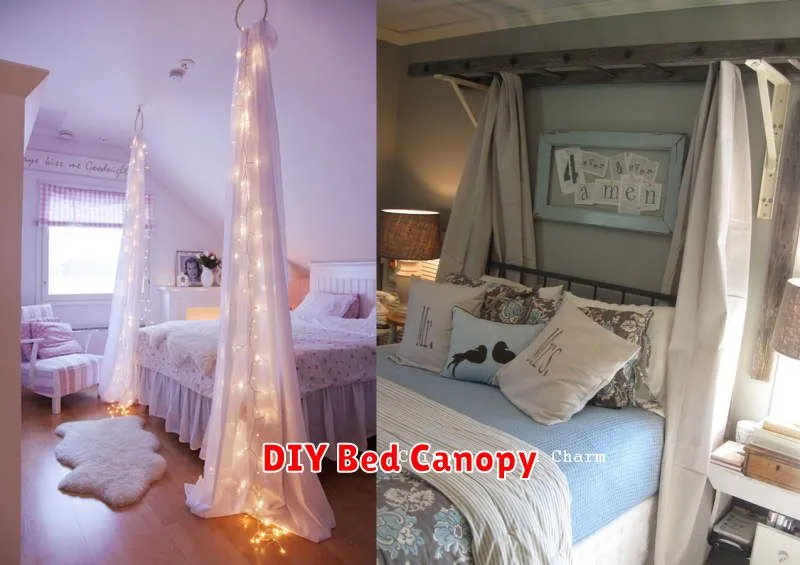
A bed canopy adds a touch of elegance and whimsy to any bedroom. It creates a cozy, private space, perfect for reading, relaxing, or simply enjoying a peaceful night’s sleep. While store-bought canopies can be expensive, creating your own is a surprisingly simple and affordable DIY project. This guide will walk you through the process of making your own beautiful and functional bed canopy.
Materials you will need: The specific materials will depend on the style and size of your canopy. However, some common essentials include: fabric (sheer fabrics like chiffon or voile work well for a light and airy feel; heavier fabrics like linen or cotton provide more privacy), a curtain rod or dowel (consider the length and diameter needed to fit your bed and desired drape), rings or clips (to attach the fabric to the rod), sewing machine (or needle and thread), measuring tape, scissors, and possibly some decorative elements like tassels or lace.
Step-by-step instructions: Begin by measuring the space above your bed where you want the canopy to hang. This will determine the amount of fabric you need to purchase. Cut your fabric to the desired size, adding extra for hems and seams. Next, create a simple hem around the edges of the fabric. Then, using your chosen rings or clips, attach the fabric evenly to the curtain rod or dowel. Finally, hang the rod or dowel securely above your bed. Consider adding decorative elements like tassels or lace to personalize the look.
Customization options: The beauty of a DIY project is the ability to personalize it to your own taste. Experiment with different fabrics, colors, and embellishments. A sheer fabric creates a romantic and dreamy atmosphere, while a heavier fabric offers more privacy and seclusion. You can also add fairy lights for a magical touch or use different hanging methods, such as tying the fabric to the ceiling or using four posts for a more elaborate structure.
Tips for success: Accurate measurements are crucial for a well-fitting canopy. Pre-wash your fabric to prevent shrinkage. If you’re not confident in your sewing skills, consider using no-sew methods such as fabric glue or hemming tape. Most importantly, have fun and enjoy the process of creating a unique and personal addition to your bedroom.
Install String Lights
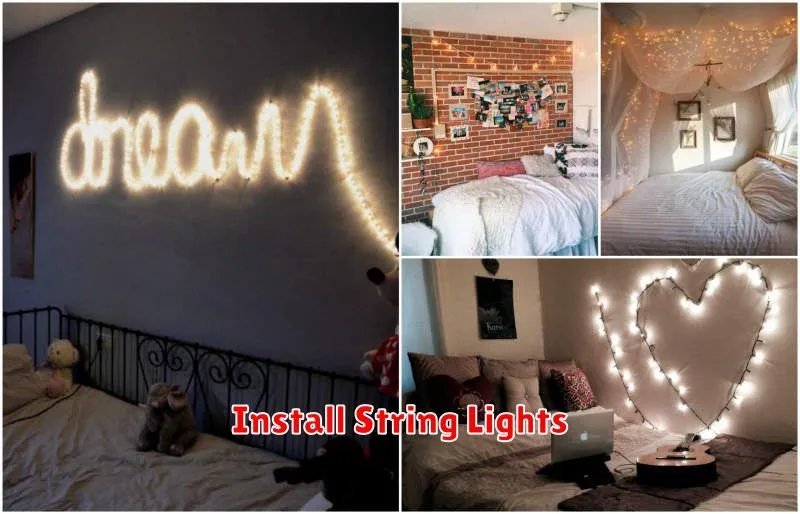
Installing string lights can dramatically enhance the ambiance of any space, both indoors and outdoors. This guide provides a step-by-step process to ensure a safe and successful installation.
Step 1: Planning and Preparation is crucial. Before you begin, carefully measure the area where you’ll be installing the lights. This will help you determine the length of string lights needed and the best placement for optimal effect. Consider the power source – whether you’ll need an outdoor-rated extension cord and where you’ll plug it in. Safety should be your top priority; ensure you have the right tools and understand any potential hazards.
Step 2: Choosing the Right Lights is essential for the overall aesthetic and functionality. Consider the type of bulb (LED, incandescent, etc.), the light color (warm white, cool white, colored), and the style (fairy lights, globe lights, etc.). Make sure the lights are rated for the intended location (indoor or outdoor) to avoid damage or electrical hazards.
Step 3: Mounting the Lights varies depending on the location and type of lights. For indoor installations, you can use clips, hooks, or adhesive strips to secure the lights to walls, ceilings, or furniture. Outdoor installations often require sturdier mounting options like stakes, clips designed for outdoor use, or attaching them to existing structures. Always ensure a secure attachment to prevent the lights from falling.
Step 4: Connecting the Lights involves carefully following the manufacturer’s instructions. For longer strings, you may need to connect multiple strands. Ensure all connections are secure and protected from the elements (if outdoors) to avoid short circuits or malfunctions. Test the lights before fully securing them to ensure everything is working correctly.
Step 5: Final Touches involve making any necessary adjustments to ensure the lights are evenly spaced and aesthetically pleasing. Take the time to admire your handiwork! Remember regular inspection and maintenance, especially for outdoor installations, to ensure longevity and prevent hazards.
Safety Precautions: Always disconnect the power before making any adjustments or repairs. Never overload circuits, and always use outdoor-rated extension cords and lights for outdoor installations. Be mindful of potential hazards such as sharp objects or fragile surfaces during installation.
Incorporate Wall Shelves
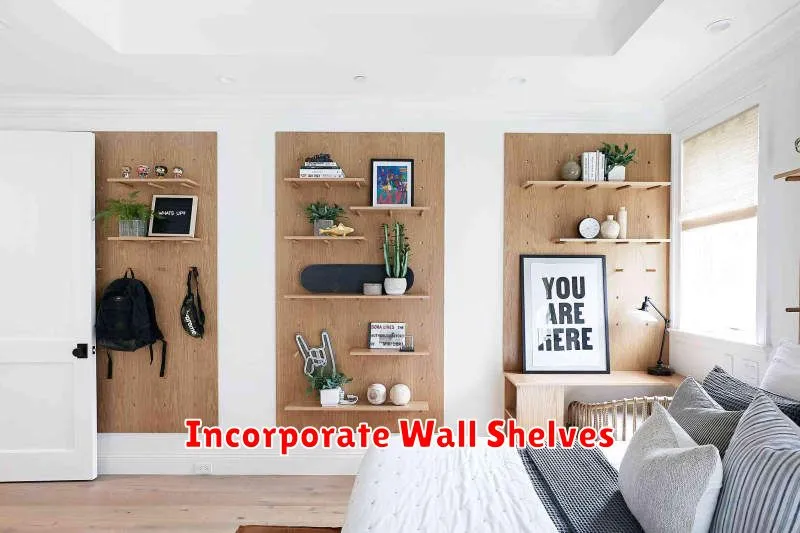
Maximize your space and add visual interest with wall shelves. They’re a fantastic way to showcase decorative items, books, or even plants, while also providing extra storage.
Consider the size and style of shelves to complement your existing décor. Floating shelves offer a minimalist look, while more traditional styles can add a touch of rustic charm. Placement is key; strategically position shelves to highlight focal points or create a sense of balance.
Functionality is another important factor. Think about what you’ll store on the shelves and choose a material and size accordingly. For example, sturdy shelves made of wood or metal are ideal for heavier items, while lighter materials like glass or acrylic are better suited for decorative objects.
Don’t underestimate the impact of styling your shelves. Group similar items together, vary heights and textures, and incorporate elements like baskets or trays to create a cohesive and visually appealing display. Adding lighting can further enhance the shelves’ aesthetic appeal and make them a true focal point of the room.
Ultimately, incorporating wall shelves is an affordable and effective way to improve both the functionality and style of any room in your home. With a little creativity, you can transform bare walls into stunning and practical features.
Paint an Accent Wall
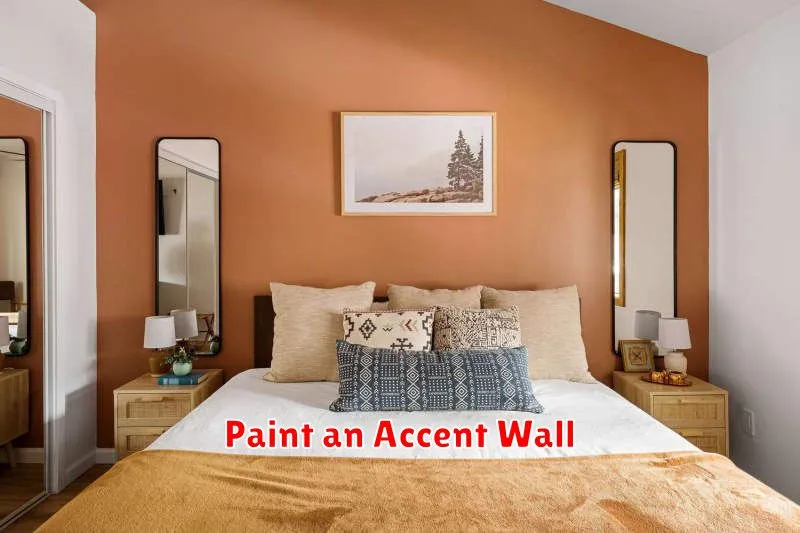
Adding an accent wall to your room is a fantastic way to inject personality and style without a major overhaul. It’s a relatively inexpensive and easily achievable DIY project that can dramatically impact the overall feel of a space.
Choosing the right color is paramount. Consider the existing color palette of your room. Complementary colors can create a balanced and sophisticated look, while contrasting colors offer a bolder, more dramatic effect. Think about the mood you want to create; calming blues and greens for relaxation, or energetic reds and yellows for vibrancy.
Preparation is key to a professional-looking finish. Begin by thoroughly cleaning the wall to remove any dust, dirt, or cobwebs. Use painter’s tape to carefully mask off the areas you don’t want to paint, ensuring a crisp, clean line. Apply a primer if necessary, especially if you’re painting over a dark color or a heavily textured surface. This will help the paint adhere better and provide a more even coat.
When it comes to applying the paint, use a high-quality brush or roller for the best results. Apply thin, even coats, allowing each coat to dry completely before applying the next. Two coats are usually sufficient for good coverage. Remember to clean your brushes and rollers immediately after use.
After the paint has fully dried, carefully remove the painter’s tape. Once complete, admire your newly transformed space! An accent wall can make a room feel more spacious, add a focal point, or even subtly alter the perception of size and shape. The possibilities are endless!

